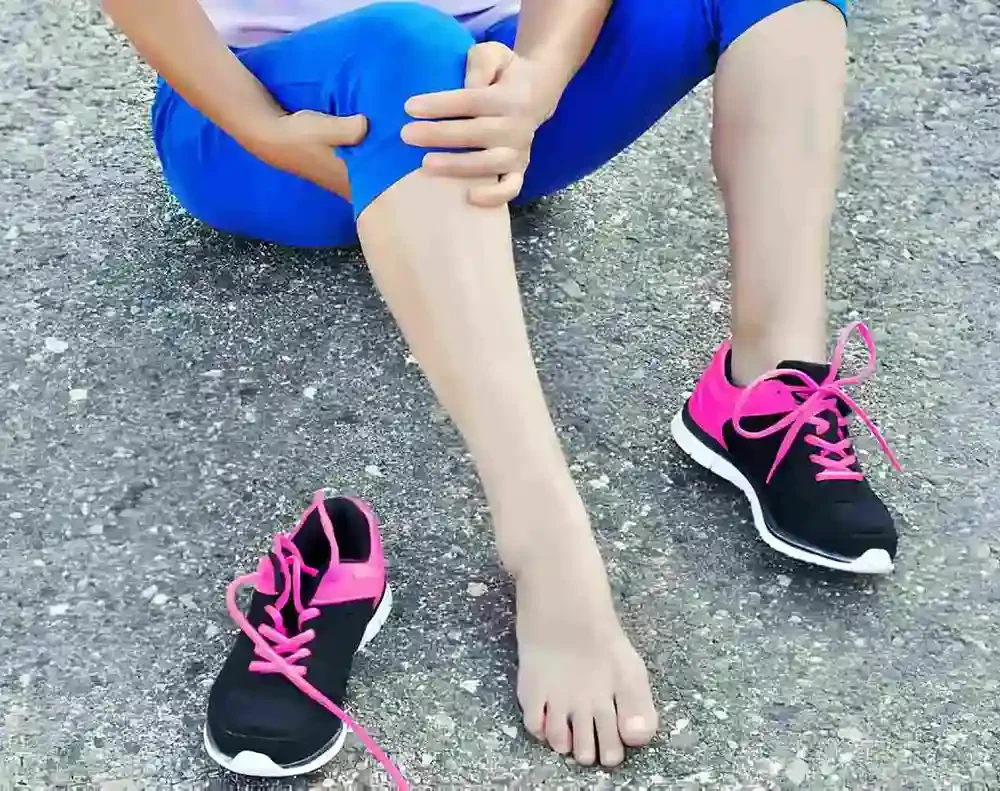
Last Updated on August 28, 2025 by Beth Skwarecki
Plantar fasciitis, a foot ailment causing inflammation of the plantar fascia, is linked to foot pain and discomfort. However, recent research suggests its impact may extend beyond the foot, potentially causing complications in other body areas, including the knees. This connection has gained attention among medical professionals and researchers, as it is crucial for accurately diagnosing and treating patients with symptoms in both feet and knees.
This article delves into the intricacies of plantar fasciitis and knee pain, exploring their characteristics, common causes, and treatment options. It also examines the biomechanical factors that underlie the connection between these two conditions and discusses the implications for patient care and management.
Understanding Plantar Fasciitis
Plantar fasciitis is a prevalent orthopedic condition characterized by inflammation and microtears in the plantar fascia, a thick band of tissue that runs along the bottom of the foot, connecting the heel bone to the toes. This condition is a leading cause of heel pain, particularly among athletes, individuals who are overweight, and those who spend prolonged periods standing or walking on hard surfaces.
Anatomy of the Foot:
- Overview of the Plantar Fascia: The plantar fascia is a resilient collagen fiber structure that supports the foot arch and facilitates standard foot mechanics during walking, running, and jumping.
- Role of the Plantar Fascia: The plantar fascia acts as a shock absorber, helping to distribute the forces generated during weight-bearing activities and maintaining the integrity of the foot’s arch.
Causes and Risk Factors of Plantar Fasciitis:
- Overuse and Repetitive Stress: Activities that involve repetitive stress on the feet, i.e., running, dancing, or standing for prolonged periods, can strain the plantar fascia, leading to inflammation and pain.
- Biomechanical Factors: Abnormal foot mechanics, including flat feet (pes planus), high arches (pes cavus), or excessive pronation, can increase the likelihood of developing plantar fasciitis by placing undue strain on the plantar fascia.
- Risk Factors: Certain factors, such as age, obesity, tight calf muscles, and inadequate footwear, can predispose individuals to plantar fasciitis.
Symptoms and Diagnosis:
- Heel Pain: The hallmark of plantar fasciitis is heel pain, typically localized to the bottom of the heel or along the foot arch.
- Pain Upon Weight-Bearing: Pain is often most pronounced after periods of inactivity, such as upon waking in the morning or following prolonged periods of sitting, and tends to subside with activity.
- Diagnostic Techniques: Diagnosis is primarily based on clinical evaluation, including a thorough medical history and physical examination. Imaging studies, such as X-rays or ultrasound, may be used to rule out other causes of heel pain and confirm the diagnosis of plantar fasciitis.
By gaining a deeper understanding of plantar fasciitis’s anatomy, causes, and symptoms, healthcare professionals and individuals affected by this condition can work together to develop an effective management plan tailored to their specific needs and goals.
The Link Between Plantar Fasciitis and Knee Pain
The link between plantar fasciitis and knee pain lies in the intricate biomechanics of the lower extremities. When the plantar fascia, a band of tissue supporting the foot arch, becomes inflamed or strained, it can disrupt foot mechanics, leading to altered gait patterns and weight distribution.
These changes can create imbalances in the lower limb, affecting the alignment and stability of the knee joint. Over time, these altered biomechanics may contribute to conditions such as patellofemoral pain syndrome or iliotibial band syndrome, resulting in knee pain, stiffness, or discomfort. Obesity, overuse, and improper footwear can worsen plantar fasciitis and knee pain. Addressing plantar fasciitis promptly through treatment and preventive measures is crucial for alleviating foot discomfort and reducing the risk of secondary knee issues.
Can Plantar Fasciitis Cause Knee Pain?
Yes, plantar fasciitis can indeed cause knee pain. While plantar fasciitis primarily affects the foot, its impact can extend beyond the immediate area of discomfort. When the plantar fascia becomes inflamed or injured, it can alter the biomechanics of the foot, leading to changes in gait and weight distribution.
These alterations in foot mechanics can, in turn, affect the alignment and stability of the lower extremities, including the knees. Over time, individuals with plantar fasciitis may develop compensatory movements or abnormal gait patterns to alleviate pain in the foot, which can place additional stress on the knee joints.
Consequently, this may result in symptoms such as knee pain, stiffness, or discomfort. Furthermore, shared risk factors such as obesity, overuse, or improper footwear can exacerbate both plantar fasciitis and knee pain. Addressing plantar fasciitis promptly through proper treatment and preventive measures is crucial for alleviating foot discomfort and reducing the risk of secondary knee issues.
Can Plantar Fasciitis Cause Hip Pain?
Yes, plantar fasciitis can lead to hip pain. Let’s delve into this intricate link:
- Altered Gait: When you experience foot pain (like plantar fasciitis), your natural response is to adjust your walking pattern to minimize discomfort. This altered gait can stress different muscles and joints, potentially leading to imbalances in the hip.
- Compensatory Mechanisms: To avoid heel pain, you might unconsciously shift your weight more to one side. This asymmetric weight distribution can strain the hip on the favored side, causing discomfort.
- Misalignment: Plantar fasciitis can cause or result from misalignment in the foot. This misalignment can affect the entire kinetic chain—a series of interconnected segments and joints that move and react in response to one another. So, when one link (like the foot) is affected, it can set off a domino effect throughout the chain, including the hip.
Can Plantar Fasciitis Cause Shin Pain?
Plantar fasciitis and shin pain share some common characteristics, and their relationship is worth exploring. Let’s dive into the details:
- Overstriding: Both conditions can be influenced by overstriding—when a person takes a step with their lead foot. Overstriding affects the way you walk or run, potentially contributing to both shin splints and plantar fasciitis.
- Gait Alterations: When you experience foot pain due to plantar fasciitis, you may unconsciously alter your walking pattern to minimize discomfort. This altered gait can stress different muscles and joints, including those in the shin area.
- Biomechanical Interplay: The body operates as a connected system. Changes in one area can impact others. For instance:
- Shin splints (medial tibial stress syndrome) cause pain in the front of the shin due to inflammation around the tibia (the larger bone in the lower leg). People with flat feet are more susceptible to shin splints because the natural arch in the foot helps absorb shock during landing, and flat feet lack this cushioning.
- Plantar fasciitis symptoms typically start in the foot but can radiate up to the ankle. Changes in posture or walking can even lead to back pain. The shift in weight distribution affects muscle strain and back discomfort.
Can Plantar Fasciitis Cause Groin Pain?
While plantar fasciitis primarily affects the foot, it can indirectly contribute to groin pain.
Let’s explore this connection:
- Mechanical Interplay: The mechanics of the body are interconnected. When you experience plantar fasciitis, it can lead to changes in your gait and posture. These alterations may affect other areas, including the pelvic region.
- Collapsed Foot Arches: Plantar fasciitis is closely associated with collapsed foot arches. As the foot structure weakens, the lower limbs compensate. These changes and torsions in the lower limb can impact pelvic alignment.
- Pelvic Floor Dysfunction: Although not directly causal, the altered mechanics due to plantar fasciitis can indirectly influence the pelvic floor. Pelvic floor dysfunction may manifest as groin pain.
Can Plantar Fasciitis Cause Pain in the Calf?
Yes, plantar fasciitis can cause pain in the calf.
Plantar fasciitis primarily affects the heel, but it can indeed have an indirect impact on the calf. Let’s explore the connection in more detail:
- Altered Gait: When you experience plantar fasciitis pain, your natural response is to adjust your walking pattern to minimize discomfort. This altered gait can lead to compensatory movements and strain on other parts of the leg, including the calf.
- Tight Calves: The calf muscles and the plantar fascia are interconnected. When your calf muscles are tight, they place extra stress on the plantar fascia, causing it to stretch excessively. Over time, this repeated strain can lead to tiny tears in the plantar fascia, resulting in inflammation and pain.
- Secondary Symptom: While calf pain is not a direct symptom of plantar fasciitis, it can occur due to the altered gait pattern caused by the foot pain. Therefore, calf pain is a secondary symptom, influenced by the way you walk rather than the plantar fasciitis itself.
Preventive Measures and Treatment Approaches:
- Proper Footwear: Wearing supportive shoes with adequate cushioning and arch support can help alleviate pressure on the plantar fascia and reduce the risk of developing plantar fasciitis. Avoiding high heels and shoes with inadequate support is essential to maintain proper foot alignment.
- Stretching and Strengthening Exercises: Incorporating regular stretching and strengthening exercises for the feet, calves, and lower limbs can improve flexibility, mobility, and muscle strength, reducing the strain on the plantar fascia and promoting proper biomechanics.
- Gradual Progression of Activity: Avoid sudden increases in activity levels or intensity, as this can place undue stress on the feet and contribute to the development of plantar fasciitis. Gradually progress exercise routines and incorporate rest days to allow for adequate recovery.
- Weight Management: Maintaining a healthy weight can help reduce the strain on the plantar fascia and lower extremities, minimizing the risk of developing plantar fasciitis and associated complications such as knee or hip pain.
- Orthotic Devices: Custom orthotic inserts or arch supports can provide additional support and stability to the foot, correcting abnormal foot mechanics and reducing strain on the plantar fascia. Over-the-counter shoe inserts may also benefit individuals with mild to moderate symptoms.
- Proper Warm-Up and Cool-Down: Engage in a thorough warm-up routine before physical activity to prepare the muscles, tendons, and ligaments for exercise. Likewise, incorporate a cooldown period to facilitate muscle recovery and reduce the risk of injury.
- Rest and Recovery: Listen to your body and allow for adequate rest and recovery between periods of activity. Avoid overtraining or ignoring signs of fatigue, as this can increase the risk of injury and exacerbate symptoms of plantar fasciitis.
- Professional Evaluation and Treatment: If experiencing persistent foot pain or symptoms suggestive of plantar fasciitis, seek evaluation by a healthcare professional, such as a podiatrist or orthopedic specialist. Early intervention and appropriate treatment can help prevent the progression of plantar fasciitis and alleviate symptoms.
- Multidisciplinary Approach: Consider a multidisciplinary approach to treatment, incorporating interventions such as physical therapy, massage therapy, acupuncture, or corticosteroid injections as appropriate. Collaborating with a team of healthcare professionals can provide comprehensive care and optimize outcomes for individuals with plantar fasciitis.
By implementing these preventive measures and treatment approaches, individuals can reduce the risk of developing plantar fasciitis and associated complications, promoting optimal foot health and overall well-being.
FAQs
Conclusion
Plantar fasciitis is a common foot condition characterized by plantar fascia inflammation, affecting the foot but potentially causing other body parts like knee, hip, or lower back pain. Understanding the biomechanical connections between the foot and other parts is crucial for managing and preventing complications.
Preventive measures like proper footwear, stretching exercises, and weight management can reduce the risk of developing plantar fasciitis. Early intervention and appropriate treatment are essential for alleviating symptoms and promoting optimal foot health. A multidisciplinary approach to treatment can improve outcomes and help individuals regain mobility, alleviate pain, and enjoy an active lifestyle.

Carla specializes in writing about post-surgery recovery, pain management, and practical health tips. With a compassionate approach, Carla shares actionable strategies to ease discomfort, promote healing, and empower readers with knowledge to make recovery smoother and less stressful.